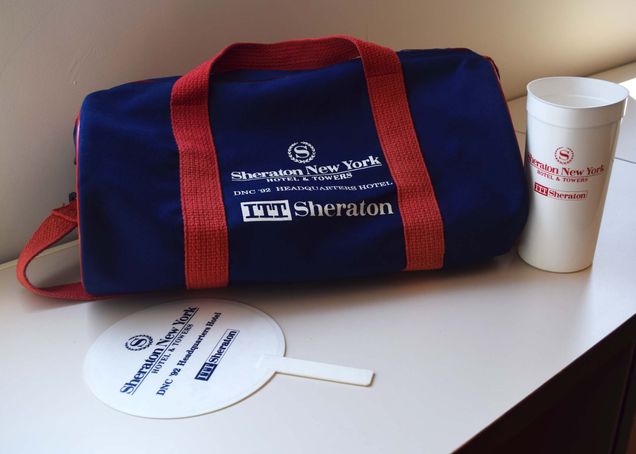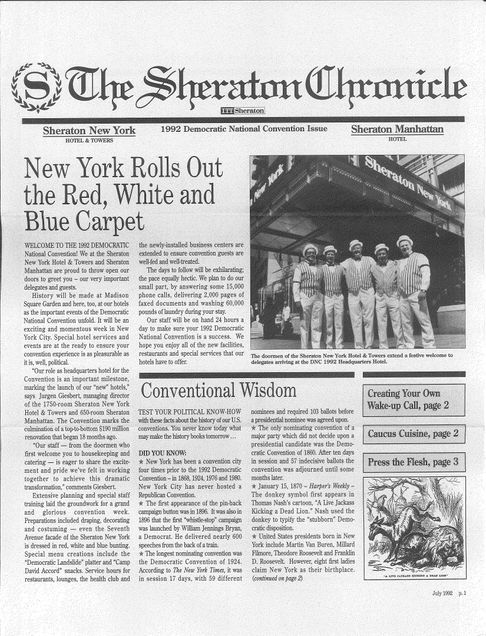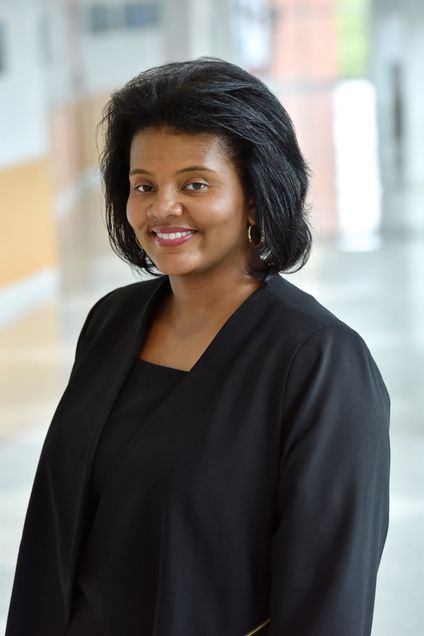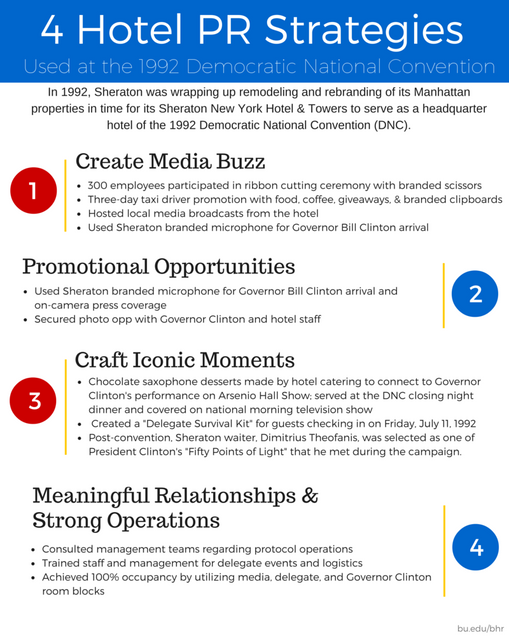Rebranding Before the Digital Age: 4 Strategies Used by the Sheraton New York Hotel and Towers During the 1992 Democratic National Convention
By Leora Halpern Lanz, Juan Lesmes, & Erinn Tucker
When a New York City tourist arrives at Times Square, the territory from 40th street to 53rd between 6th and 8th avenues, they become one of the other 330,000+ monthly visitors (Times Square Alliance) of the city’s most popular destination. The pedestrian-only square is consumed by upscale hotels, themed restaurants owned by celebrity chefs, the iconic TKTS booth selling tickets to the 40 Broadway theaters, an array of usual and unusual street performers, and towering neon lights flashing varying content like celebrity news, stock prices, and McDonald’s ads.
In the early 1990s, Times Square and New York City was not the ideal tourist destination that it is today. A fiscal crisis in 1975 was followed by power outages, increased drug usage and crime, and a declining population. By 1990, the city experienced peak homicides of 2,245 in one year. In 1993, Times Square alone reported close to 4,000 crime incidents. While the streets were lined with flashing lights and signs, these risqué attractions, however, were not for the tourists and their families that the area caters to today.
In 1992, New York City Mayor Rudolph “Rudy” Giuliani and the Times Square Alliance made drastic efforts towards the revitalization of the city, combating both poverty and crime. The hospitality industry had much to contribute to these efforts by building new luxury properties, and revitalizing existing New York properties like the Sheraton Centre Hotel. This hotel in particular was not only part of the city’s drastic efforts to turn out its safety and public image, but it simultaneously leveraged its connection to the 1992 Democratic National Convention to lift its own rebrand.
Today, the 38,960,000 annual Times Square visitors account for $4.5 billion in food, retail, and entertainment spending. The downtown destination also provides 385,000 jobs, and fewer than 800 instances of crime occur every year.
The Sheraton Ready for a Rebrand
In 1990, the 7th Avenue Sheraton Centre Hotel in Manhattan was a tired property in need of rejuvenation. Owned by International Telephone and Telegraph (ITT), the property experienced high occupancy rates and was the leading revenue generator for Sheraton. However, Fodor’s and Frommer’s guide books validated the guest point of view: it was an outdated hotel where guests only stayed if deemed absolutely necessary due to its central location and affordable rates. The guests’ perceptions and negative public stigma were indicative of many of the United States Sheraton hotel properties, which included a mixed collection of large city hotels, suburban properties and highway locations. The company instituted a strategic plan focused on renovating existing properties throughout the U.S. and Canada in order to remain competitive in the market.
Between 1990 and 1992, ITT spent $1 billion on capital and renovation efforts in order to elevate hotel quality in North America. Sheraton re-positioned their television and marketing messages, announcing, “We’re spending a billion to make you feel like a million.” ITT allocated 10%, or $100 million, of renovations to its three New York City properties: Sheraton Centre, Sheraton Squire, and Sheraton Park Avenue (respectively renamed Sheraton New York Hotel & Towers, Sheraton Manhattan, and Sheraton Russell). In 1992, the Sheraton Centre and City Squire properties collectively totaled 2,400 rooms. The Sheraton renovations and rebranding concurrently aligned with the rejuvenation of Manhattan’s Midtown West and tourist-driven 42nd Street. This made for an additional opportunity that the Sheraton Centre’s public relations department incorporated into its property’s strategy.
The Sheraton Centre and the Democratic National Convention
The 1992 Democratic National Convention was set to take place in New York City from July 13th-15th. The 1,650 room Sheraton Centre and its primary competitor, the New York Hilton located two blocks away, served as the official hotels of the DNC. The Sheraton Centre publicly capitalized on its DNC connection to help lift its rebrand and renovation messaging. For example, public relations and advertising stated, “The hotel was spending $100 million to renovate and become the new Sheraton New York Hotel & Towers; and we are completing the renovation in time to serve as the headquarters for the Democratic National Convention.” The renovation and DNC connected messaging was further shared with stakeholders, potential guests, and business bookers during the period leading up to the convention.
From Internal Customer to External Customer
Develop an Internal Narrative for Employees
It is important to use a common message to communicate renovation updates to all employees. It was most important for front-of-house employees like bellman and front-desk agents who frequently come in contact with guests; it was also important for back-of-house employees working behind-the-scenes like engineers and sales staff to be familiar with the changes. When employees were knowledgeable and up to date, the internal word-of-mouth assisted in telling the rebranding story.
Without the widespread use of internet and corporate intranets, the public relations and human resources departments developed an internal television channel called the Sheraton Employee News Network (SENN); the station delivered a weekly update on the renovations occurring at both the Sheraton Centre and Squire properties. “Renovation Updates”, a printed periodic internal newsletter also included renovation, rebranding, and DNC updates. Eventually, as the comfort with internet and email grew, department heads sent the newsletters electronically to their respective staff and departments.
Pre-Convention Public Relations MomentsBeginning in February 1992, monthly communication tactics were planned for both properties, some already leveraging the DNC connection.
|
Sheraton New York Hotel & Towers Rebrand for the External Customer
Hotels draw customers from out of town, traveling for both work and pleasure; it is imperative to employ local public relations efforts and community connections to spread the message when rebranding. For the Sheraton New York Hotel & Towers, visually appealing images of hotel employees on the construction scaffolding and positive relationships with the neighborhood and taxi drivers helped put the property in the public eye.
Convention delegates checked in to the newly rebranded Sheraton New York Hotel & Towers on Friday, July 11, 1992, two days before the official kickoff of the DNC. In an effort to avoid the common practice of only reacting to media inquiries, the hotel’s public relations team proactively capitalized on its role as an official convention hotel prior to the delegate’s check-in. Faxes and direct phone calls, the most available large-scale electronic communications at the time, were used to ensure local businesses and on-air reporters received media advisories of the hotel’s DNC delegate activities and calendar of events. In addition, Sheraton created several marketing tactics to support the strategy of leveraging the national convention to rebrand the property.

Actions Used to Support the Strategy
- Delegate Survival Kit: Red, white, and blue canvas bags with the logos of the newly-named hotels were given to each delegate on the first day of check-in. Each bag included a hand fan to use during the warm temperatures of the July convention, an NYC subway token, a map of New York City, a cup for free lemonade in the hotel lobby, a copy of the “Sheraton Chronicle” detailing hotel DNC activities, and recommended tourist attractions. This merchandising tactic permeated throughout the city; tourists were seen walking with the bags on the first day of check-in.
- Red, white, and blue banner bunting was hung proudly from the exterior of the building. While appearing as a Grand Opening banner, it also signified that the hotel was “the place” to be during the convention.
- A Dixieland jazz band, barbershop quartet, lemonade stands, and doormen dressed in straw boaters and pin-striped vests were deliberately placed at the hotels’ street level entrances. News crews zipping by looking for DNC related activities naturally stopped at the hotel with the help of these activities in full visibility. Guests and passers-by were also intrigued to come inside.
- Politically-themed movies like “All the President’s Men” and “Mr. Smith Goes to Washington” aired on loops in the Sheraton New York lobby sports bar.
- During the convention week, wines from the Clinton vineyards of upstate New York were added to the hotel menus. New York State apples were offered at the front desk along with other small touches to show appreciation for each of the present state delegates.

Leveraging Unexpected OpportunitiesDespite strategic planning and preparation, seizing unplanned moments are often the most impactful. On June 3, 1992, Governor Clinton appeared on Arsenio Hall’s popular late night talk show in what became a successful attempt to appeal to young voters. Donning dark sunglasses, Clinton enthusiastically played his saxophone resulting in a successful national performance and campaign milestone. Although presidential candidates may have appeared on late night talk shows in the past, this was the first time a candidate showed a lighter side or less formal ‘presidential image’ that is more common today. The Sheraton’s PR department quickly capitalized on this iconic moment.
|
2016: The Republican and Democratic National Conventions
During political conventions, while hotels are sold out and host cities are abuzz, a hotel’s public relations, marketing, and operations department’s goals include leveraging its connection to the event while maximizing rate and occupancy opportunities. In addition to the immediate profitability any convention offers, a national political convention may also provide the opportunity to gain greater countrywide recognition for a longer term positive impact.
With the 2016 Republican National Convention in Cleveland, Ohio and the Democratic National Convention in Philadelphia, Pennsylvania, upon us this summer, hotel marketers and their public relations campaigns will focus much more on digital and mobile strategies to leverage the impact these conventions provide. Already, the Democratic National Convention Committee and its host city led a Twitter chat to answer questions specifically for the surrounding food and beverage industry. They also partnered with Google to prepare workshops aimed at helping small businesses enhance their online presence before and during the convention.
The Hilton Cleveland Downtown, the RNC’s headquarter hotel, will find itself in a situation similar to that of the 1992 launch of the Sheraton New York. The brand new $272 million Hilton hotel with 600 guestrooms will open its doors on June 1, 2016, just seven weeks before the convention kicks off. The goal of branding (or rebranding) a hotel by leveraging the exposure of a national convention can bring is the same in 1992 or 2016. Although this summer the available tools are more varied and diverse than 24 years ago, so is the competition for attention with the multitude of media channels and fragmented interests of the country. From a hoteliers marketing perspective, the intrigue of the democratic and republican conventions battling for which candidates and political platforms will represent their respective parties will contend with professional interest as to the public relations success of the host hotels.
 Leora Halpern Lanz is President of LHL Communications and a full time lecturer at Boston University’s School of Hospitality Administration. She served as the Director of Public Relations for the Sheraton Hotels of New York from 1990-1999. A graduate of Cornell University with a Masters from Boston University, Leora served for 15 years as Global Director of Marketing for HVS, nearly 10 years as Director of Public Relations and Advertising for the ITT Sheraton Hotels of New York, and nearly 5 years as the Director of Public Relations for the Greater Boston Convention & Visitors Bureau. leora@lhlcommunications.com; lhlanz@Bu.edu; @LeoraLanz2
Leora Halpern Lanz is President of LHL Communications and a full time lecturer at Boston University’s School of Hospitality Administration. She served as the Director of Public Relations for the Sheraton Hotels of New York from 1990-1999. A graduate of Cornell University with a Masters from Boston University, Leora served for 15 years as Global Director of Marketing for HVS, nearly 10 years as Director of Public Relations and Advertising for the ITT Sheraton Hotels of New York, and nearly 5 years as the Director of Public Relations for the Greater Boston Convention & Visitors Bureau. leora@lhlcommunications.com; lhlanz@Bu.edu; @LeoraLanz2
 Juan Lesmes is a rising senior at Boston University’s School of Hospitality Administration. His studies and areas of interest include hospitality media relations and integrated marketing communications. Juan’s previous experience includes work at public relations firm DataMedia Communications Group and at digital marketing platform Let’s Get Weddy in London. He is currently working with LHL Communications. Beyond his studies at SHA, he serves as co-founder and marketing coordinator of Boston University’s International Society. After graduation, Juan intends to continue his studies in hospitality marketing and communications.
Juan Lesmes is a rising senior at Boston University’s School of Hospitality Administration. His studies and areas of interest include hospitality media relations and integrated marketing communications. Juan’s previous experience includes work at public relations firm DataMedia Communications Group and at digital marketing platform Let’s Get Weddy in London. He is currently working with LHL Communications. Beyond his studies at SHA, he serves as co-founder and marketing coordinator of Boston University’s International Society. After graduation, Juan intends to continue his studies in hospitality marketing and communications.
 Erinn Tucker, Ph.D. is an Assistant Professor in the School Tourism and Hospitality Management at Temple University. She has 20 years of corporate and academic experience. Her teaching and research is in the areas of event management and student engagement. She holds a bachelor’s degree in business administration from Florida A&M University, a master’s degree in sport administration from Florida State University and a Master’s in Business Administration (MBA) from Winthrop University and Ph.D. in Hospitality Administration from Oklahoma State University. Email: erinn.tucker@temple.edu or @erinntucker
Erinn Tucker, Ph.D. is an Assistant Professor in the School Tourism and Hospitality Management at Temple University. She has 20 years of corporate and academic experience. Her teaching and research is in the areas of event management and student engagement. She holds a bachelor’s degree in business administration from Florida A&M University, a master’s degree in sport administration from Florida State University and a Master’s in Business Administration (MBA) from Winthrop University and Ph.D. in Hospitality Administration from Oklahoma State University. Email: erinn.tucker@temple.edu or @erinntucker

5 comments
I’m thinking some of my readers might find a bit of this interesting and very helpful article post to me. I am really so happy with this. Thank you and Good luck dear admin.
Dental Implant Treatment In Jaipur
Thanks For Sharing Such an Amazing Post.
Buy Wooden Furniture for home
Thanks for the info. Now I understood whole
9 Seater Tempo Traveller In Jaipur
Hi admin thank You.
tempo traveller in Jaipur
Thanks for the info very helpful article
Luxury Tempo Traveller Rental Rajasthan